Follow education curator Karen Povey and head veterinarian Dr. Karen Wolf as they visit the rainforests of Borneo to work with other conservation experts to learn how we can preserve habitats for clouded leopards and other species.
Tuesday July 28, 2015
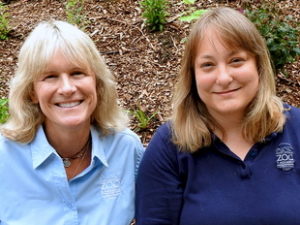
We’re off to the rainforest! Dr. Karen Wolf, PDZA’s Head Veterinarian (pictured at right), and I, Education Curator Karen Povey (at left), are off this week to visit the Danau Girang Field Centre (DGFC) on the island of Borneo. DGFC, located on the banks of the Kinabatangan River in the Malaysian state of Sabah, is a research and training facility managed by the Sabah Wildlife Department and Cardiff University. Scientists and university students from around the world visit the Centre to learn forest conservation and research techniques and to conduct studies on tropical ecology.
The Zoo’s Dr. Holly Reed Conservation Fund and the non-profit Clouded Leopard Project have provided financial support for DGFC’s clouded leopard research and community education efforts for several years. This visit will allow us to continue to build our partnership and explore additional ways to collaborate in the future. We’ll be delivering donated field research equipment, taking part in a carnivore outreach school program, and accompanying clouded leopard researchers in the field. It’s a long shot that we’ll actually get a glimpse of an elusive cloudie, but we should experience all sorts of amazing wildlife such as the Borneo pygmy elephant, proboscis monkeys, hornbills, lots of cool bugs and spiders (Dr. Karen isn’t too excited about those), and no doubt the infamous tiger leeches!
Check back for reports from the field and more information about the pioneering clouded leopard studies taking place here.
Selamat tinggal – goodbye for now!
Monday August 3, 2015
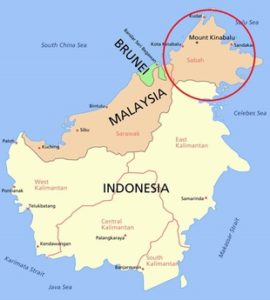 After a marathon couple of travel days, we’ve arrived in Kota Kinabalu, the capital of Malaysian Borneo. The city hugs the shore of the South China Sea and provides beautiful vistas of the ocean and surrounding islands. KK, as the locals call it, will serve as our base for all the activities of the next couple of weeks. Our host, Benoit Goossens, the director of the Danau Girang Field Centre, kindly arranged a number of opportunities for us to get a great overview of the projects we’ve supported and the variety of work they do in research, education, and even fighting illegal wildlife trade.
After a marathon couple of travel days, we’ve arrived in Kota Kinabalu, the capital of Malaysian Borneo. The city hugs the shore of the South China Sea and provides beautiful vistas of the ocean and surrounding islands. KK, as the locals call it, will serve as our base for all the activities of the next couple of weeks. Our host, Benoit Goossens, the director of the Danau Girang Field Centre, kindly arranged a number of opportunities for us to get a great overview of the projects we’ve supported and the variety of work they do in research, education, and even fighting illegal wildlife trade.
We’re really excited about the timing of this visit as it coincides with a planned school outreach by the Sabah Wildlife Department (SWD) outreach team of Clarice Kelly Samih and Xenia Surinday Stimol. We spent the morning meeting with them to learn more about their environmental education programming, including the carnivore education program supported by PDZA. The SWD also recently initiated a program called the 5Rs that focuses on reducing the hunting and trade of wildlife, a serious issue in Sabah. Many of the students reached by Clarice and Xenia’s lessons have grown up hunting in Sabah’s forests so it’s vital to teach them to value wildlife as a living part of their heritage and break the tradition of wildlife consumption in the country.
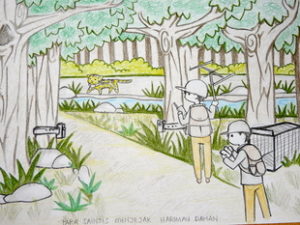
I’ll write more about the outreach efforts we visit the schools, but one component is assessing the impact of the program on students’ knowledge of carnivores and wildlife research as well as on their attitudes about wildlife. To do this, students are asked to draw pictures representing the work of wildlife researchers both at the start and the end of the program and to depict clouded leopard habitat. The results are remarkable! Before their lessons, students know virtually nothing about clouded leopards and other carnivores and have attitudes toward these animals that are fearful or consider them a commodity to be used. But afterwards, their pictures demonstrate so much new knowledge about how researchers learn about clouded leopards and the cat’s role in the ecosystem.
Tuesday August 4, 2015
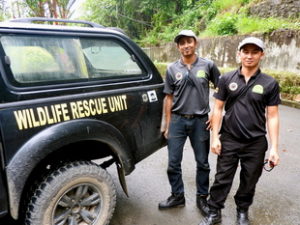
Wildlife trade is a serious problem throughout Southeast Asia – huge numbers of animals are captured from the wild to be sold as pets, cooked up as delicacies, or have their body parts made into medicines. In Borneo, wildlife trafficking is a serious offense and the Sabah Wildlife Department is tasked with trying to curb this disturbing trade to protect the region’s rarest species.
Sadly, clouded leopards have increasingly become part of this trade. Just this week, SWD made an important arrest that resulted in the confiscation of a young clouded leopard. Rangers from their Enforcement and Wildlife Rescue units had been working undercover to cultivate a relationship with a man selling protected wildlife using social media to advertise. Ultimately, this led to him offering a clouded leopard cub for sale for approximately $1500. Upon arranging a meeting to complete the sale, the man was arrested and now faces a serious fine and jail time if convicted.
We were lucky enough to meet Dr. Pakeeyaraj, a veterinarian for the Wildlife Rescue Team, who described the investigation and took us to see the young cat, now housed at the Lok Kawi Wildlife Park. Despite the circumstances, it was wonderful to have my first-ever glimpse of the Sunda clouded leopard (Neofelis diardi)! This is a different species than the mainland clouded leopards (Neofelis nebulosa) we have at the zoo. While they look similar, Sunda clouded leopards are usually notably darker and have more dense spotting.
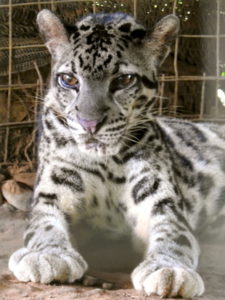
We couldn’t photograph the confiscated cat or the three other previously seized animals that live behind the scenes, but did get to see another one on exhibit. She was also a victim of the wildlife trade, having been captured and kept as a pet when young.
It was inspiring to meet Dr. Pakeeyaraj and his colleague Hasni B. Koungin. I so admire the dedication of all the Sabah Wildlife Department rangers to the dangerous work of confronting poachers and protecting Borneo’s amazing creatures. We should all be grateful for the work they do.
Thursday August 13, 2015
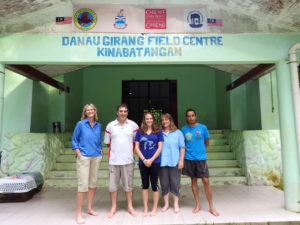 Wow, what a week we’ve had! Dr. Karen and I are just back from visiting the Danau Girang Field Center in the heart of the rainforest and were blown away by all we’ve seen and done. The highlights included live trapping civets for satellite collaring, radio tracking slow lorises and tarsier (one of the most amazing creatures imaginable!), checking clouded leopard live traps (sadly, no captures), climbing into the canopy, and observing all sorts of wildlife by boat and on walks through the jungle during both day and night.
Wow, what a week we’ve had! Dr. Karen and I are just back from visiting the Danau Girang Field Center in the heart of the rainforest and were blown away by all we’ve seen and done. The highlights included live trapping civets for satellite collaring, radio tracking slow lorises and tarsier (one of the most amazing creatures imaginable!), checking clouded leopard live traps (sadly, no captures), climbing into the canopy, and observing all sorts of wildlife by boat and on walks through the jungle during both day and night.
Through it all we were accompanied by DGFC’s dedicated team of researchers and their student assistants. While the wildlife was cool, these guys absolutely made the trip by sharing their passion for their work and being so generous with their time with us.
There is SO much to tell and I plan to compile some videos highlighting some of our adventures in the days to come. You can expect Borneo pygmy elephants, proboscis monkeys, orangutans, hornbills, bugs, frogs, and so much more.
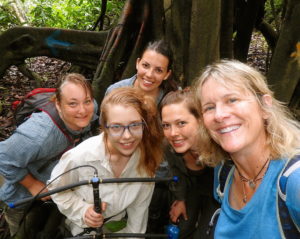 Dr. Karen, myself, and the researchers we support are so grateful for PDZA members and other donors to the Dr. Holly Reed Conservation Fund. Traveling to Borneo to meet our conservation partners is essential for forging ongoing relationships between their work and all that we do at the Zoo to engage our community in protecting nature around the world. I’m so eager to tell their stories; I guarantee you’ll be inspired!
Dr. Karen, myself, and the researchers we support are so grateful for PDZA members and other donors to the Dr. Holly Reed Conservation Fund. Traveling to Borneo to meet our conservation partners is essential for forging ongoing relationships between their work and all that we do at the Zoo to engage our community in protecting nature around the world. I’m so eager to tell their stories; I guarantee you’ll be inspired!
Monday August 17, 2015
Malaysia is one of the world’s top producers of palm oil. It’s one thing to know that fact; it’s quite another to drive across the island of Borneo and pass nothing but oil palm plantations for mile after mile to offer a new perspective. We were startled to see the enormous impact this crop has had on transforming what was once rich rainforest habitat to farmland. We pulled over at one high point on the road and could see nothing but palm trees covering the hillsides completely to the horizon. Much of the traffic on the highway consists of trucks carrying the palm fruit to mills for processing or tanker trucks full of palm oil heading to ports for export.
We also had the opportunity to get a close-up view of a plantation.
Please visit the Zoo’s Protecting the Rainforest page to learn how you can help ensure protection of Borneo’s remaining forests for clouded leopards, gibbons, elephants, and all the other creatures that depend on them.